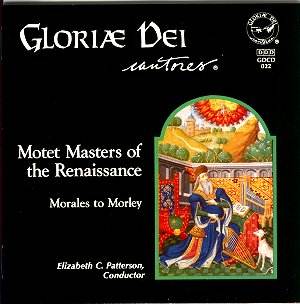Amateur choirs have reason to be grateful to
Chester Music's books of motets, each volume generally devoted
to renaissance motets from a particular national school. Under
the editorship of Anthony Petti, they make this lovely repertoire
freely available to choirs, in editions which are suitable for
a mixed choir. Whilst some of this music is apt to be tricky,
none is of extreme difficulty and the motets can form a useful
means of providing a varied selection of items in a concert.
This CD consists of 18 motets, grouped according
to national school along with Lassus's lovely mass 'Missa super
Bella Amfitrit altera'. The national schools featured are the
Italian, Flemish, German, Spanish and English. This division is
a convenient one in publishing terms. But, with the increasing
internationalisation of sacred music at this period, I am not
sure the division is very helpful. After all, Lassus spent much
of his mature working life in Munich. Peter Philips was mainly
based in the Low Countries, as a result of his religious convictions
and de Wert spent his entire working life in Italy.
Whilst motets from these books are useful in
programming terms, I am not sure that a complete recital of them
makes particularly imaginative programming. All are aimed at about
the same level of difficulty. What I missed in this programme
was the sense of something new, perhaps something a little daring
to pull the programme together. As it is, the recital rather lacks
focus and proceeds in quite a leisurely way from motet to motet.
Gloriae Dei Cantores are a voluntary choir, based
at the Church of the Transfiguration, Orleans, Massachusetts where
they sing services regularly. At full strength the group number
36, though split into smaller groups for some of the works on
this record. They are recorded in quite a generous acoustic and
make a satisfying, blended sound. When the whole choir is singing,
they make a fine noise but I felt that I was missing details that
I would have heard in a performance by a smaller group. Also,
the choir's technique and the recorded ambience would seem more
suitable to late 19th and 20th century music
than this repertoire. They have, in fact, made a fine recording
of Rubbra motets. Too often I found a real sense of line lacking;
a fatal tendency to think vertically, to produce a nice blended
chord, rather than producing a focused line with ongoing horizontal
momentum.
As regards the actual performances, Elizabeth
Patterson favours rather steady speeds, contributing to the lack
of variety. Too often I felt that joyful passages lacked impetus
and liveliness. Viadana's 'Exsultate justi', which opens the programme,
could have been far more vital. Here, as elsewhere, the more rhythmic
passages lack a certain crispness. The choir is at its best in
the slower, sustained numbers. The opening of Peter Philips’ 'Tibi
laus', set just for high voices, is a lovely example of the choir's
sustained singing. But as the piece develops, their performance
rather stalls as they fail to inject the rhythms with the necessary
vibrancy.
In the Lassus mass, the finest moments are those
climactic ones where the choir's size and weight are suitable
for the music and we can revel in the sheer joy of the noise without
worrying too much about loss of detail. The moments sung by smaller
groups meant that slight weaknesses in individual singers were
exposed.
This is the problem with recording with a non-professional
group with singers from a mix of backgrounds. This recording is
very fine and entirely creditable, but there are still moments
of weakness. By and large the recording engineers have done a
good job, but some entries display hesitancy and there is an occasional
smudged quality to the passage work.
There are 21 different composers on this disk
and some are not very well represented in the catalogue, but this
is not an ideal programme either in terms of programming or performance.
If you are a choral singer who sings this repertoire regularly,
you would probably find this recording interesting and enlightening.
All the motets are given in good sober performances. But if you
just have an interest in this repertoire, then I suggest you try
exploring some of the Tallis Scholars compilation CDs or one of
Jeremy Summerly and the Oxford Camerata's recordings for Naxos.
Robert Hugill


